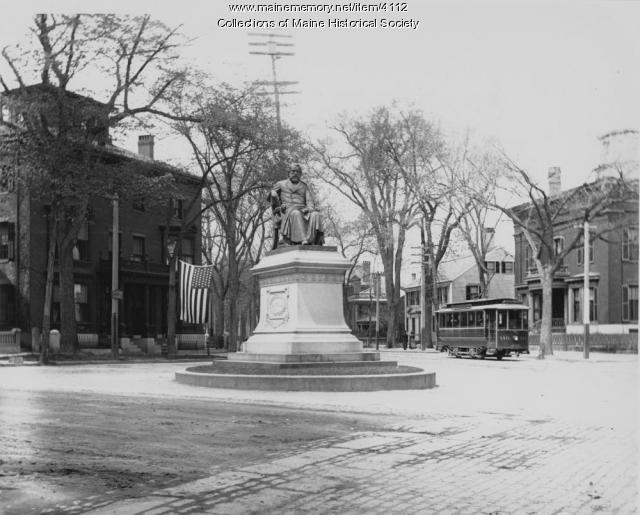Keywords: Brunswick, Maine
Item 11723
Contributed by: Maine Historical Society Date: 1747-07-06 Location: Brunswick Media: Ink on paper
Item 34545
Eliza J. Knight, Brunswick, ca. 1850
Contributed by: Pejepscot History Center Date: circa 1850 Location: Brunswick; Bath Media: Photographic print
Item 150306
Town Hall at Brunswick, Brunswick, 1882
Contributed by: Maine Historical Society Date: 1882 Location: Brunswick Client: Town of Brunswick Architect: Fassett & Stevens Architects
Item 151699
Brunswick Savings Institution, Brunswick, 1937-1945
Contributed by: Maine Historical Society Date: 1937–1945 Location: Brunswick Client: Brunswick Savings Institution Architect: John Howard Stevens and John Calvin Stevens II Architects
Exhibit
The boundaries of Maine are the product of international conflict, economic competition, political fights, and contested development. The boundaries are expressions of human values; people determined the shape of Maine.
Exhibit
The Swinging Bridge: Walking Across the Androscoggin
Built in 1892 to entice workers at the Cabot Manufacturing Corporation in Brunswick to move to newly built housing in Topsham, the Androscoggin Pedestrian "Swinging" Bridge or Le Petit Pont quickly became important to many people traveling between the two communities.
Site Page
Early Maine Photography - Occupational Photography
"Captain Gross lived in Brunswick and Topsham until his death in 1855 at the age of 45. Slightly later in time is the ambrotype of Captain Lewis…"
Site Page
Maine's Road to Statehood - The Final Vote
"… Society For several months after the heated Brunswick Convention, separation was only a whisper."
Story
30 years of business in Maine
by Raj & Bina Sharma
30 years of business, raising a family, & showcasing our culture in Maine
Story
Moving from Washington to Maine with the Navy
by Tom Jarvis
Maine's forests, mill history, and volunteer work keep me here
Lesson Plan
Maine's Acadian Community: "Evangeline," Le Grand Dérangement, and Cultural Survival
Grade Level: 9-12
Content Area: English Language Arts, Social Studies
This lesson plan will introduce students to the history of the forced expulsion of thousands of people from Acadia, the Romantic look back at the tragedy in Henry Wadsworth Longfellow's famous epic poem Evangeline and the heroine's adoption as an Acadian cultural figure, and Maine's Acadian community today, along with their relations with Acadian New Brunswick and Nova Scotia residents and others in the Acadian Diaspora. Students will read and discuss primary documents, compare and contrast Le Grand Dérangement to other forced expulsions in Maine history and discuss the significance of cultural survival amidst hardships brought on by treaties, wars, and legislation.
Lesson Plan
Longfellow Studies: An American Studies Approach to Henry Wadsworth Longfellow
Grade Level: 6-8, 9-12
Content Area: English Language Arts, Social Studies
Henry Wadsworth Longfellow was truly a man of his time and of his nation; this native of Portland, Maine and graduate of Bowdoin College in Brunswick, Maine became an American icon. Lines from his poems intersperse our daily speech and the characters of his long narrative poems have become part of American myth. Longfellow's fame was international; scholars, politicians, heads-of-state and everyday people read and memorized his poems. Our goal is to show that just as Longfellow reacted to and participated in his times, so his poetry participated in shaping and defining American culture and literature.
The following unit plan introduces and demonstrates an American Studies approach to the life and work of Longfellow. Because the collaborative work that forms the basis for this unit was partially responsible for leading the two of us to complete the American & New England Studies Masters program at University of Southern Maine, we returned there for a working definition of "American Studies approach" as it applies to the grade level classroom. Joe Conforti, who was director at the time we both went through the program, offered some useful clarifying comments and explanation. He reminded us that such a focus provides a holistic approach to the life and work of an author. It sets a work of literature in a broad cultural and historical context as well as in the context of the poet's life. The aim of an American Studies approach is to "broaden the context of a work to illuminate the American past" (Conforti) for your students.
We have found this approach to have multiple benefits at the classroom and research level. It brings the poems and the poet alive for students and connects with other curricular work, especially social studies. When linked with a Maine history unit, it helps to place Portland and Maine in an historical and cultural context. It also provides an inviting atmosphere for the in-depth study of the mechanics of Longfellow's poetry.
What follows is a set of lesson plans that form a unit of study. The biographical "anchor" that we have used for this unit is an out-of-print biography An American Bard: The story of Henry Wadsworth Longfellow, by Ruth Langland Holberg, Thomas Y. Crowell & Company, c1963. Permission has been requested to make this work available as a downloadable file off this web page, but in the meantime, used copies are readily and cheaply available from various vendors. The poem we have chosen to demonstrate our approach is "Paul Revere's Ride." The worksheets were developed by Judy Donahue, the explanatory essays researched and written by the two of us, and our sources are cited below. We have also included a list of helpful links. When possible we have included helpful material in text format, or have supplied site links. Our complete unit includes other Longfellow poems with the same approach, but in the interest of time and space, they are not included. Please feel free to contact us with questions and comments.



















